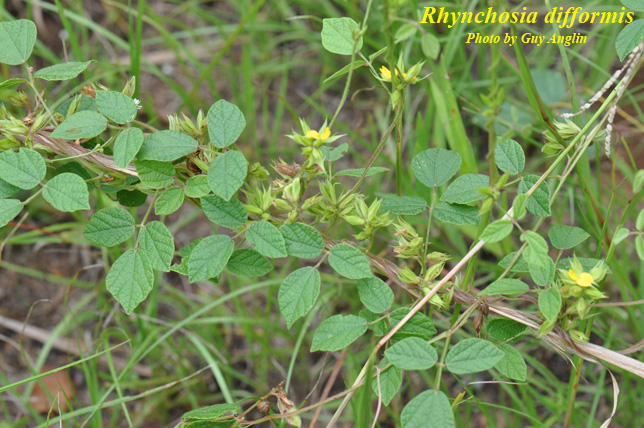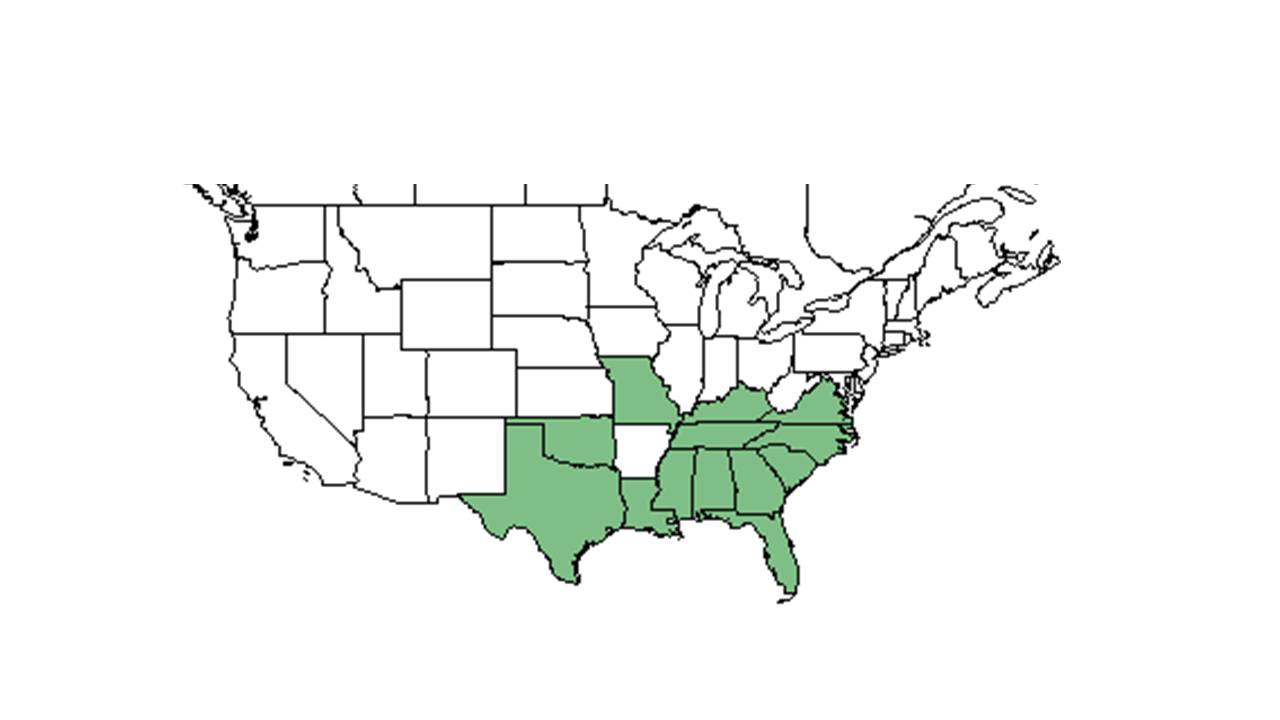Rhynchosia difformis
| Rhynchosia difformis | |
|---|---|

| |
| Photo by Guy Anglin, Atlas of Florida Vascular Plants | |
| Scientific classification | |
| Kingdom: | Plantae |
| Division: | Magnoliophyta – Flowering plants |
| Class: | Magnoliopsida – Dicotyledons |
| Order: | Fabales |
| Family: | Fabaceae ⁄ Leguminosae |
| Genus: | Rhynchosia |
| Species: | R. difformis |
| Binomial name | |
| Rhynchosia difformis (Elliott) DC. | |

| |
| Natural range of Rhynchosia difformis from USDA NRCS Plants Database. | |
Common name: Doubleform snoutbean
Contents
Taxonomic notes
Synonym: R. tomentosa Small -misapplied
Description
Rhynchosia difformis is a perennial herbaceous vine.
“Erect, trailing or climbing, perennial herbs or shrubs. Leaves pinnately 3-foliolate or occasionally 1-foliolate; leaflets usually entire and often bearing amber glands, usually estipellate; stipules ovate to lanceolate. Flowers papilionaceous, rarely solitary or in pairs but usually in axillary or occasionally also terminal racemes, several to numerous, loose to compactly clustered, pedicellate, each subtended by a caduceus bract. Calyx tube campanulate or tubular, nearly regular, lobes equal or nearly so in size but with the 2 uppermost partially united; petals yellow in ours, often equaling or even shorter than the calyx; stamens diadelphous, 9 and 1. Legume usually oblong and flattened, 1-2 seeded, dehiscent."[1]
"Prostrate or climbing vine0.5-1 m long with strongly angled, tawny-pubescent stems. Leaves mostly 3-foliolate but the lowermost usually 1-foliolate; leaflets of the 1-foliolate leaves reniform while those of the 3-foliolateleavse usually orbicular to ovate or widely elliptic (the lateral often asymmetric), 1.5-4 cm long, conspicuously reticulate, short-pubescent and conspicuously glandular on both surfaces, stipels lacking; stipules persistent, ovate to ovate-lanceolate, 3-8 mm long. Racemes axillary, 1.5-4 cm long, subsessile or with peduncles to 3 cm long with 2-8 closely clustered flowers on pedicels 1-5 mm long each subtended by a caduceus, linear bract 2-5 mm long. Calyx densely appressed to ovate-lanceolate, 6-10 mm long, long-acuminate to subulate; petals yellow, 7-9 mm long. Legume 1.5-2 cm long, 6-8 mm broad, pilose, inconspicuously glandular."[1]
The root system of Rhynchosia difformis includes stem tubers which store non-structural carbohydrates (NSC) important for both resprouting following fire and persisting during long periods of fire exclusion.[2] Diaz-Toribio and Putz (2021) recorded this species to have an NSC concentration of 176.4 mg/g (ranking 27 out of 100 species studied) and water content of 70% (ranking 26 out of 100 species studied).[2]
Distribution
Rhynchosia difformis is endemic to the longleaf pine range from southeastern Virginia to central Florida and west to southeast Texas with disjunct populations in the Eastern Highland Rim and Cumberland Plateau regions of Tennessee and Kentucky.[3]
Ecology
Habitat
R. difformis occurs in dry sandy soil, and in open light conditions .[4] It can be found in longleaf pine-wiregrass-scrub oak communities, sandhills, and mixed hardwood woodlands and hammocks.[4] However, it can also be found in disturbed areas, including roadsides and power line corridors.[4]
Associated species include Pinus palustris, Quercus incana, Q. laevis, Q. margaretta, Q. stellata, Aristida stricta, Desmodium ochroleucum, Commelina erecta, Schoenus nigricans, Rhynchospora, Scleria, Juniperus, and Danthonia sericea.[4]
Phenology
R. difformis has been observed flowering April through August and in October.[4][5] Fruiting has been observed in May through August, as well as October.[4]
Seed dispersal
This species is thought to be dispersed by consumption by vertebrates.[6]
Fire ecology
This species has been found in habitat that is maintained by periodic fire,[4] and populations of Rhynchosia difformis have been known to persist through repeated annual burns.[7][8]
Conservation, cultivation, and restoration
Cultural use
Photo Gallery
References and notes
- ↑ 1.0 1.1 Radford, Albert E., Harry E. Ahles, and C. Ritchie Bell. Manual of the Vascular Flora of the Carolinas. 1964, 1968. The University of North Carolina Press. 638. Print.
- ↑ 2.0 2.1 Diaz-Toribio, M.H. and F. E. Putz 2021. Underground carbohydrate stores and storage organs in fire-maintained longleaf pine savannas in Florida, USA. American Journal of Botany 108: 432-442.
- ↑ Sorrie, B. A. and A. S. Weakley 2001. Coastal Plain valcular plant endemics: Phytogeographic patterns. Castanea 66: 50-82.
- ↑ 4.0 4.1 4.2 4.3 4.4 4.5 4.6 Florida State University Robert K. Godfrey Herbarium database. URL: http://herbarium.bio.fsu.edu. Last accessed: June 2014. Collectors: Loran C. Anderson, W. C. Holmes, Harry E. Ahles, J. Haesloop, R.K. Godfrey, Wilson Baker, Bill & Pam Anderson, C. Jackson, James D. McClain, L. Cecil King, R. C. Phillips, Richard S. Mitchell, Richard D. Houk, William Lindsey, Rodie White, R. A. Norris, Cecil R Slaughter, and Richard R. Clinebell II. States and Counties: Florida: Clay, Columbia, Dixie, Flagler, Franklin, Gadsden, Gilchrist, Hamilton, Jackson, Jefferson, Leon, Marion, Polk, Suwannee, Wakulla, and Washington. Georgia: Beaufort, Grady, McIntosh, and Thomas. South Carolina: Dorchester, and Jasper. Louisiana: Natchitoches.
- ↑ Nelson, G. PanFlora: Plant data for the eastern United States with emphasis on the Southeastern Coastal Plains, Florida, and the Florida Panhandle. www.gilnelson.com/PanFlora/ Accessed: 13 DEC 2016
- ↑ Kirkman, L. Katherine. Unpublished database of seed dispersal mode of plants found in Coastal Plain longleaf pine-grasslands of the Jones Ecological Research Center, Georgia.
- ↑ Robertson, K.M. Unpublished data collected from Pebble Hill Fire Plots, Pebble Hill Plantation, Thomasville, Georgia.
- ↑ Platt, W.J., R. Carter, G. Nelson, W. Baker, S. Hermann, J. Kane, L. Anderson, M. Smith, K. Robertson. 2021. Unpublished species list of Wade Tract old-growth longleaf pine savanna, Thomasville, Georgia.